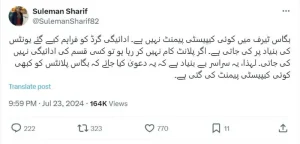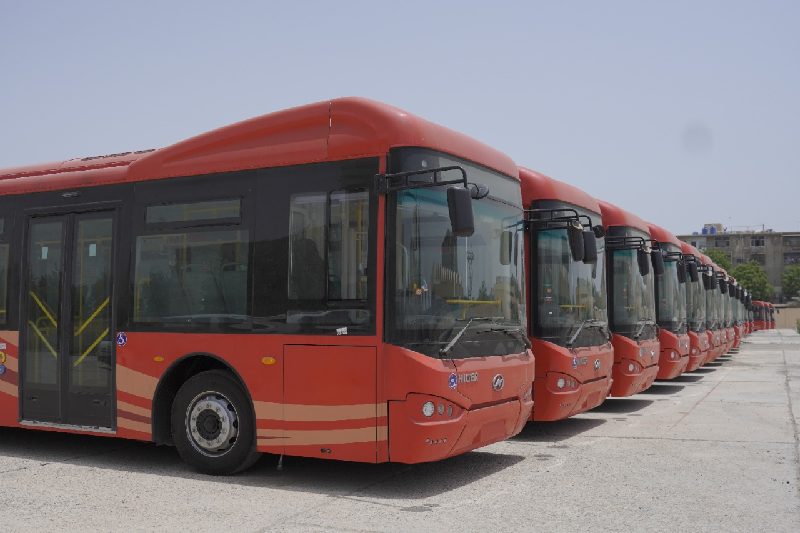For the past several days, payments made to private power plants (IPPs) in Pakistan, known as capacity payments, have been under discussion.
While many people are questioning why these plants, which do not generate electricity, need to be paid billions of rupees, others allege that the real beneficiaries behind these IPPs are the country’s elite, including politicians and business personalities, who are unfairly profiting from them.
In this context, Pakistan’s Prime Minister Mian Shehbaz Sharif’s son, Suleman Shehbaz, is also being accused of benefiting from capacity payments to his power plant.
On Tuesday, he stated in a message on the social media site X (formerly Twitter) that capacity payments are not made for electricity generated from bagasse.
According to him, bagasse-powered electricity plants, which use sugarcane residue, are only paid for the electricity they supply to the grid, and if the plant is not operating, it does not receive any payment.
Now the question arises whether bagasse-powered power plants really do not receive capacity payments and who the owners of the IPPs in the country are.
But first, it is important to understand what the issue of capacity payments is.

Capacity Payment Explained
The discussion about capacity payments began when Pakistan’s former caretaker Minister of Commerce, Gohar Ejaz, released details of payments made to power plants on his X account. He claimed that during the last fiscal year, power plants received 1900 billion rupees in capacity payments.
Capacity payment refers to the monthly payment made by consumers to power-generating companies to maintain their electricity production capacity. This ensures that additional electricity can be provided in case of increased demand. If a plant does not generate electricity at full capacity due to low demand, it still receives capacity payments to remain operational.
The message shared by Suleman Shehbaz on X is significant because his company, Chiniot Power Company, is included in the list of companies that received capacity payments as per Gohar Ejaz’s post. According to the Pakistan Credit Rating Agency (PACRA), Suleman Shehbaz Sharif is the CEO of Chiniot Power Company and owns 94% of its shares. Chiniot Power is part of the Sharif Group.
What are Bagasse Plants and How Many are There in Pakistan?
Bagasse is the residue left after sugarcane crushing in a sugar mill, used as fuel for electricity generation. Besides generating electricity within sugar mills, it can also be used in other power plants.
Currently, there are eight IPPs in Pakistan that generate electricity from bagasse. Seven of these are in Punjab, and one is in Sindh, with a combined installed capacity of 259 megawatts.
According to the statistics on the website of the Private Power and Infrastructure Board, a subsidiary of the Ministry of Energy, the bagasse-powered plants include:
- JDW Sugar Mills (Unit II) and JDW Sugar Mills (Unit III), owned by politician Jahangir Tareen’s JDW Group.
- Chiniot Power, owned by Suleman Shehbaz.
- Rahim Yar Khan Sugar Mills
- Layyah Sugar Mills
- Almoiz Industries
- Chanar Energy Limited
These plants utilize bagasse to produce electricity.
Do Bagasse Power Plants Receive Capacity Payments?
Experts in the energy sector were consulted regarding Suleman Shehbaz’s claim, and they explained that electricity generation from bagasse occurs in a specific season. During this season, these power plants do receive capacity payments.
Energy expert Ammar Habib told BBC Urdu that during the sugarcane crushing season, when bagasse is available, the plants operate, and companies receive capacity payments. Ammar clarified that these companies do not necessarily receive capacity payments throughout the year, as the plants do not run year-round. Capacity payments are only made when the plant is capable of generating electricity.
Former Chairman of the National Electric Power Regulatory Authority (NEPRA), Tauseef Farooqi, also confirmed to BBC Urdu that bagasse plants receive capacity payments during the crushing season when they can produce electricity. He stated that there is no justification for such payments during the non-crushing season when these plants are inactive.
Gohar Ejaz’s list on X also mentions capacity payments to bagasse power plants. According to these lists, companies that received payments from January to March this year include Chiniot Power, JDW II, JDW III, and other bagasse-powered plants.
Ownership of IPPs in Pakistan
The ownership of IPPs in Pakistan has been a topic of various opinions on social media platforms. Currently, there are 100 IPPs in Pakistan:
- 15 run on furnace oil
- 19 run on gas and RLNG
- 4 hydropower IPPs
- 3 run on imported coal
- 5 run on Thar coal
- 8 run on bagasse
- 10 solar power plants
- 36 wind power plants
Most IPPs’ ownership details are not readily available to the public due to the confidentiality clauses in power purchase agreements. However, information on plants listed on the stock market is accessible. According to the Private Power and Infrastructure Board (PPIB), bagasse power plants include:
- JDW Sugar Mills (Unit II) and JDW Sugar Mills (Unit III) owned by Jahangir Tareen’s JDW Group.
- Chiniot Power owned by Suleman Shehbaz.
- Rahim Yar Khan Sugar Mills
- Layyah Sugar Mills
- Almoiz Industries
- Chanar Energy Limited
Nishat Power Plant, running on furnace oil, is owned by Mansha Group, with Mian Hassan Mansha, the son of prominent businessman Mian Mansha, serving as the board chairman. Lalpir Power Plant is also owned by Nishat Group. Orient Power Company has 22% shares owned by Nadeem Babar, former petroleum advisor during Imran Khan’s tenure. Saif Power Project is owned by Saif Group of Companies, linked to the Saifullah political family from Khyber Pakhtunkhwa. Engro Power Project is owned by Engro Energy Limited, part of the Dawood Group.
Experts note that the perception that most power plants are owned by politicians is incorrect. Ammar Habib mentioned that more than half of the plants are government-owned or have government holdings. There are also Chinese company plants installed under CPEC and private investor plants. Dr. Fayyaz Chaudhry, Director of the LUMS Energy Institute, emphasized that discussing IPP ownership is irrelevant as both local and foreign investors will seek guarantees for their investments.
The Capacity Payment Issue
Commenting on the capacity payment debate, former NEPRA Chairman Tauseef Farooqi noted that these payments have been made for many years without much discussion. However, as the dollar rate increased and payment amounts significantly rose, this burden on consumers sparked the debate. Farooqi pointed out that if Pakistan’s economy grew at a 7% annual rate, the electricity demand would justify these plants, but economic growth has been insufficient.
He mentioned that during the PTI government, capacity payment rates were fixed at 148 rupees per dollar for 25 to 30 power plants, preventing a greater burden on consumers when the dollar rate surged in the past two years. Otherwise, payments would have been made at 280 rupees per dollar, further straining consumers.
Reference: BBC Urdu (Translated by chatgpt)




